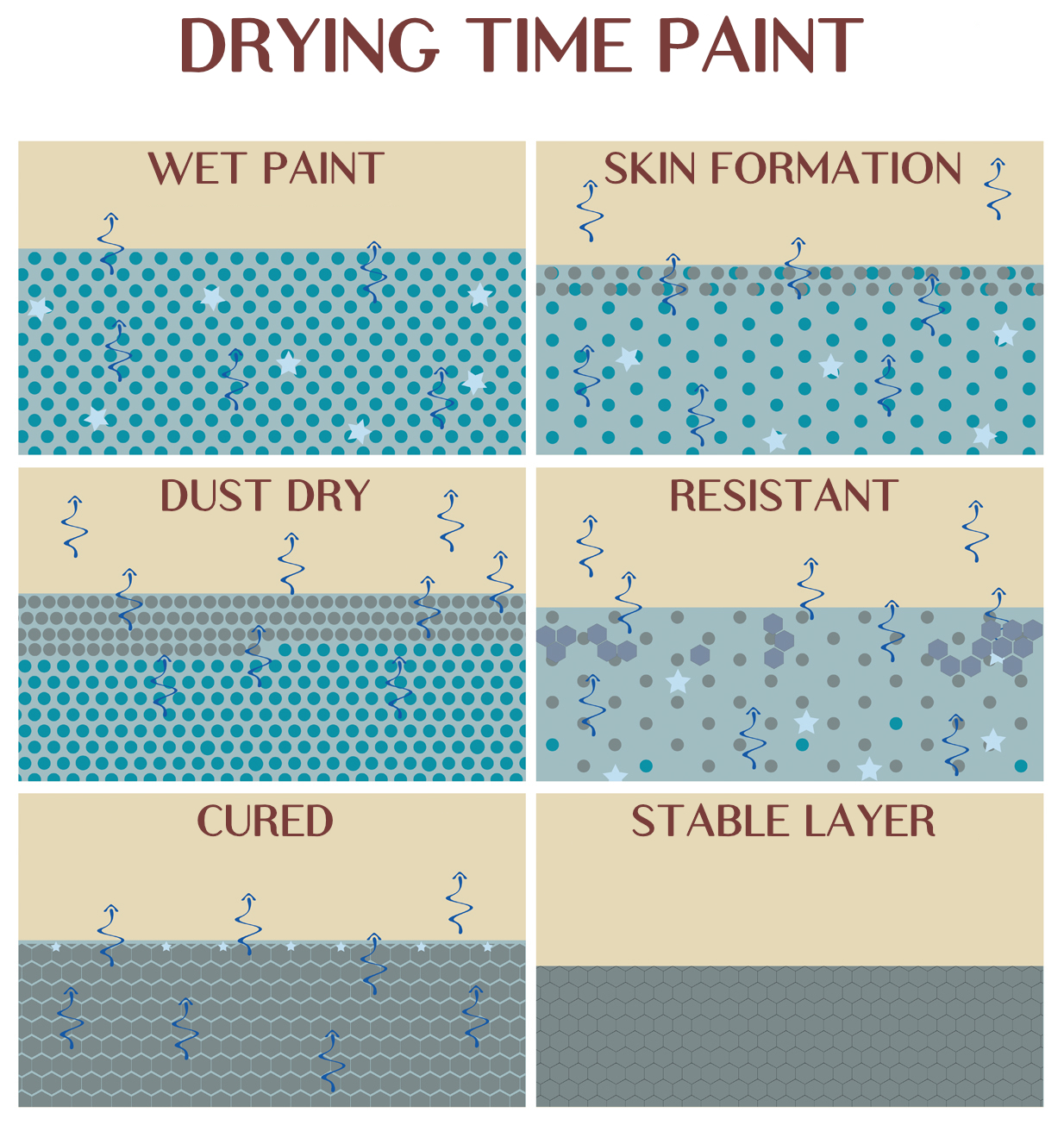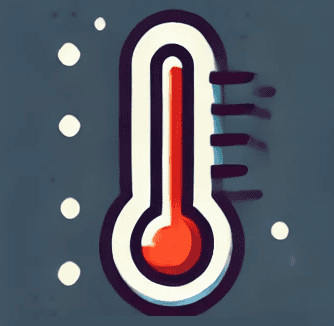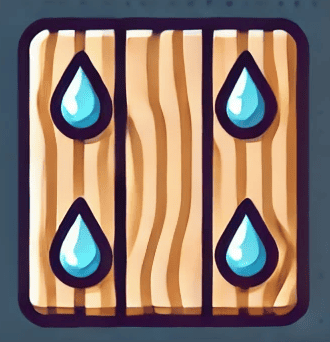Drying time
An important consideration with a waterborne paint is the drying time. The time it takes for the paint to dry can vary from a few hours to several weeks!
On this page, we explain how the drying time is affected and how you could speed it up. The most important factors are temperature, humidity and the amount of ventilation. In addition, layer thickness and the humidity of the wood also play a role.
The different stages of the drying process
This water-based paint dries by releasing its water into the air. Although a water-based paint may sometimes appear to dry very quickly, it can still take quite some time to fully cure. Like a cake in the oven, paint needs time and the right environment to fully ‘cure’. It is not just the outside that dries; the inner layers also need to cure for a durable result.
1. Wet paint – this is the paint as it comes out of the container. The moment you apply it to the wood, the paint still contains all the moisture.
2. Skin formation – a kind of dry skin often starts to form on the surface very quickly, especially when the weather is very hot. The paint begins to dry and becomes matt.
3. Dust dry – fairly soon after, the paint is dust dry: the paint feels dry to the surface and you can lightly touch it without paint coming off.
Careful: if you start recoating when the layer is already dust-dry, you will notice that you are ‘pulling off’ the paint again. With the pressure of the brush, you push through the dry layer and actually brush through the wet layer again. You are then effectively not applying new paint.

4. Resistant – the paint layer no longer contains visible wet spots. Make no mistake: the paint has not yet fully dried. This stage can be misleading, because although the paint can withstand a light rain shower, for example, it will come off if you rub it with a wet cloth.
5. Cured – almost all the moisture has been pulled out of the paint and the remaining parts of the paint have ‘melted together’, so to speak. Usually this is seen as the final stage because the paint has formed a fairly constant layer by then, although the paint actually has a final stage.
6. Stable layer – even after the paint has cured, there will still be a tiny bit of moisture in it. These tiny particles eventually also migrate out of the paint layer, leaving behind tiny ‘passages’. These ensure that moisture can still be drawn out of the wood later. So the paint layer continues to ‘breathe’.
What affects the drying time of paint?
Compare drying paint with hanging laundry. Whether you hang it outside on the clothsline or inside, depends on the temperature, humidity and whether there is a breeze. It really makes a difference whether the laundry is soaking wet or has been centrifuged. On a summer day with a high temperature, the laundry will definitely dry.
On an autumn day, with a temperature of 12 °C, the laundry will dry only when the humidity is low and when there is a breeze. If the weather is cold and humid, everyone knows the chances are very high that the laundry wont dry before another rainstorm passes by.
There are multiple elements that could influence the drying time.
Temperature

Temperature is of the utmost importance. Above 20 °C the paint dries like crazy. You could often times repaint after 6 hours, and after 2-3 days the paint can withstand a rainstorm.
When the temperature is low (and especially when combined with high humidity) the paint can’t dry properly. This will considerably lengthen the time it takes to dry. During that time, there is a high risk that a rainstorm will wash off the paint. So it is best to avoid painting at a temperature below 15 °C.
The months April to September are ideal for painting with Moose Färg paint: there are many days with a good temperature and lower humidity.
Are the temperatures dropping outside? You could opt to paint indoors. Ideally, do this in a room with good insulation or heating so that the temperature is not too low.
Humidity

Humidity plays an important part. Don’t paint when the humidity is over 80%. Ideally, it should be around 40%.
Drying paint in a high-humidity environment is like trying to dry clothes on a humid, foggy day. When the air is saturated with moisture, the water in the paint cannot evaporate easily, just as wet clothes on a humid day take much longer to dry. The paint stays wet longer and dries slower because there is no room in the air to absorb the moisture.
Humidity is especially high in autumn and winter, but even on warmer days humidity could be high. Even indoors, with the windows closed, humidity is often higher than expected.
Good to know: As long as the humidity is high, not only will the paint have a hard time drying, it may even become wetter. As long as there is still moisture in the paint layer, it can absorb moisture from the air. This usually only occurs when humidity levels are extremely high.
Ventilation

Good air circulation ensures that moist air is removed and dry air can circulate. It is like opening a window in a warm room: the fresh air takes the moisture outside, allowing the paint to dry faster.
With insufficient ventilation, the moist air lingers around the painted surfaces, slowing down the evaporation of the moisture in the paint. This can lead to longer drying times and uneven drying. So ventilation is like a breath of fresh air that helps the paint breathe and dry optimally.
Outside, ventilation is usually not a problem. Indoors, we often keep windows and doors closed in winter, which can cause local humidity to rise unnoticed.
So are you painting indoors? Open a window or door from time to time.
Layer thickness

The thickness of the paint layer also affects the drying time. A thin layer of paint dries faster than a thick layer. Compare it to baking a thin pancake versus a thick cake – the latter always takes longer to fully cook.
A thick layer of paint may feel dry faster on the outside (surface drying; skin formation), while the paint is still wet on the inside (penetration drying). The paint then remains vulnerable for a long time and may even cause it to shine. A thin layer of paint allows the moisture to evaporate faster, which ensures more consistent drying throughout.
Thin layers dry faster and adhere better, making the paint more uniform and stronger.
Moisture content in wood

The moisture content in wood can also affect the drying time of a water-based paint. When wood has a high moisture content, moisture can remain under the paint layer, causing the paint to stay wet for longer and dry slowly or unevenly. In some cases, the moisture can even migrate through the paint layer, leading to problems such as discolouration.
Moisture in wood is particularly common when the wood is very fresh. A tree trunk’s job was to carry moisture from the ground to the leaves, so if it has just been cut, there is still a lot of moisture in the wood. If the wood has been lying or standing for a bit longer, the moisture draws out.
A moisture content of 15% is usually considered ideal for painting. You can ask the wood supplier what the moisture content of his wood is, or use a moisture meter. If in doubt, prefer to let the wood stand or lie for a while before painting it.
How long does paint need to dry?
The question you are naturally looking for answers to is: when exactly is the paint dry?
Because so many factors influence it, it cannot be defined in minutes, hours or even days.
As a guideline: if you paint outside and the daytime temperature is 20 °C, the paint will be recoatable after 6 hours and dry enough to withstand a rainstorm after 2-3 days.
With the tips below, you can improve the drying time:
When painting outdoors
- Preferably do not paint outside below 15 °C. Temperature greatly affects drying time: for every 5 degrees less, the length of drying time squares. So below 15 degrees, the drying time will be more than a week. There is too good a chance that a rainstorm will hit.
- Always apply several thin layers rather than one thick layer.
- Have you painted already, but unexpected rain is coming? Cover everything with a tarpaulin so that the paint layer does not come into contact with the moisture. Remove the tarpaulin in dry weather to allow plenty of fresh air to reach the paint.
- If the humidity is above 80%, it is best not to paint. There is then so much moisture in the air that the paint cannot ‘give’ its moisture to the air, and therefore cannot dry.
When painting indoors
- Keep in mind that there is little air circulation or ventilation inside. This can increase drying time. If necessary, open a window or door to improve ventilation. This usually helps the humidity as well. You can also place a fan in the room.
- If you are painting in autumn or winter, the paint will not dry properly in rooms without heating. So always factor in a longer drying time.
- Painting inside and then placing it outside? That can be an excellent solution, for example when you paint in autumn and there is too much chance of rain. In that case, however, take into account a longer drying time because of the lack of ventilation, higher humidity (especially in a shed or garage) and possibly a lower temperature. The tips from points 1 and 2 will help to speed up drying. Do not place the wood outside when it still gives off when you grip it.
- Always apply several thin layers rather than 1 very thick one.
Would you like additional, personal advice?
We are happy to help. Send an e-mail or call +31(0) 6 55 333 165. Watch our Instruction Video for more information. Apply here for a free color-card.

